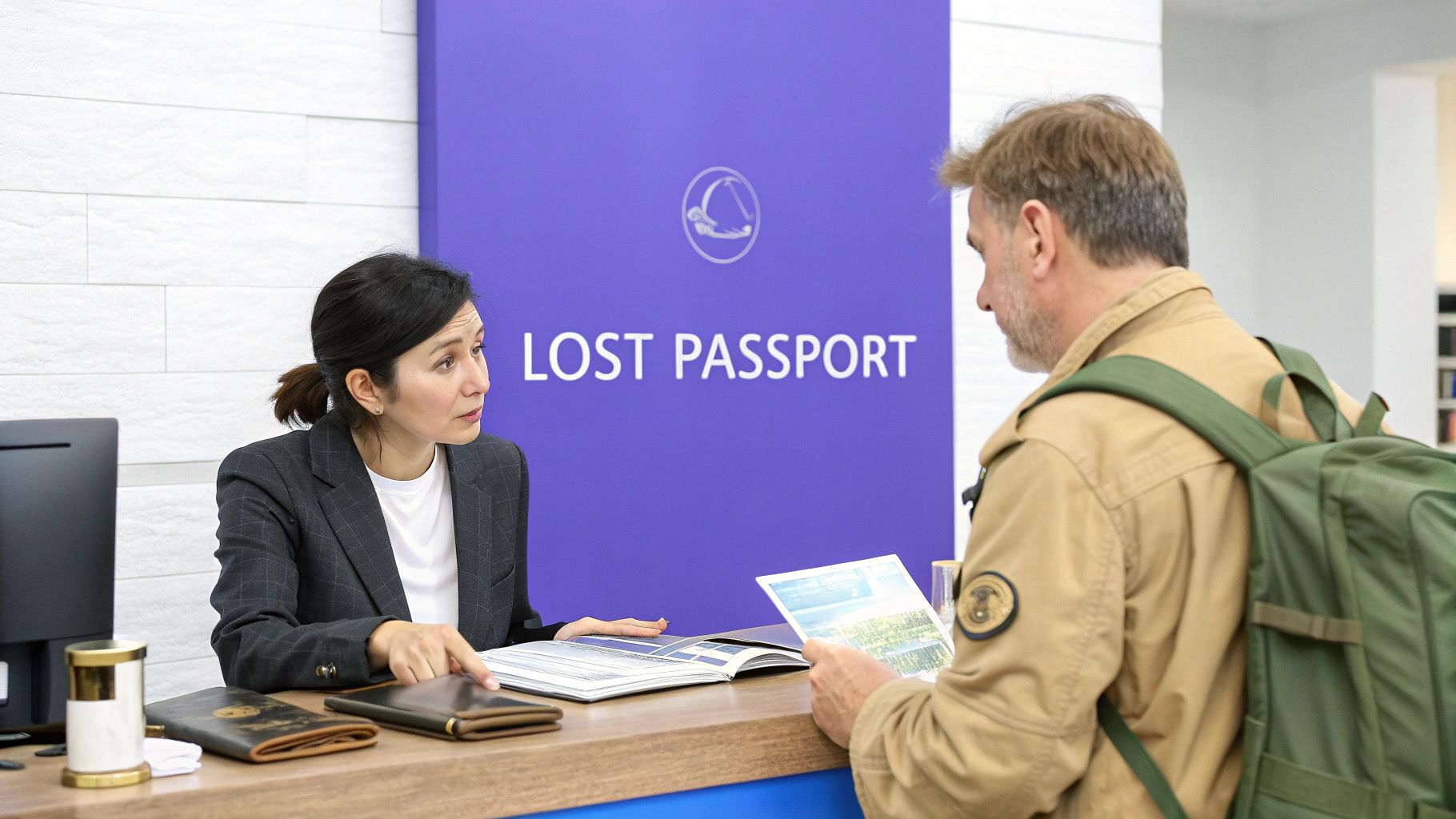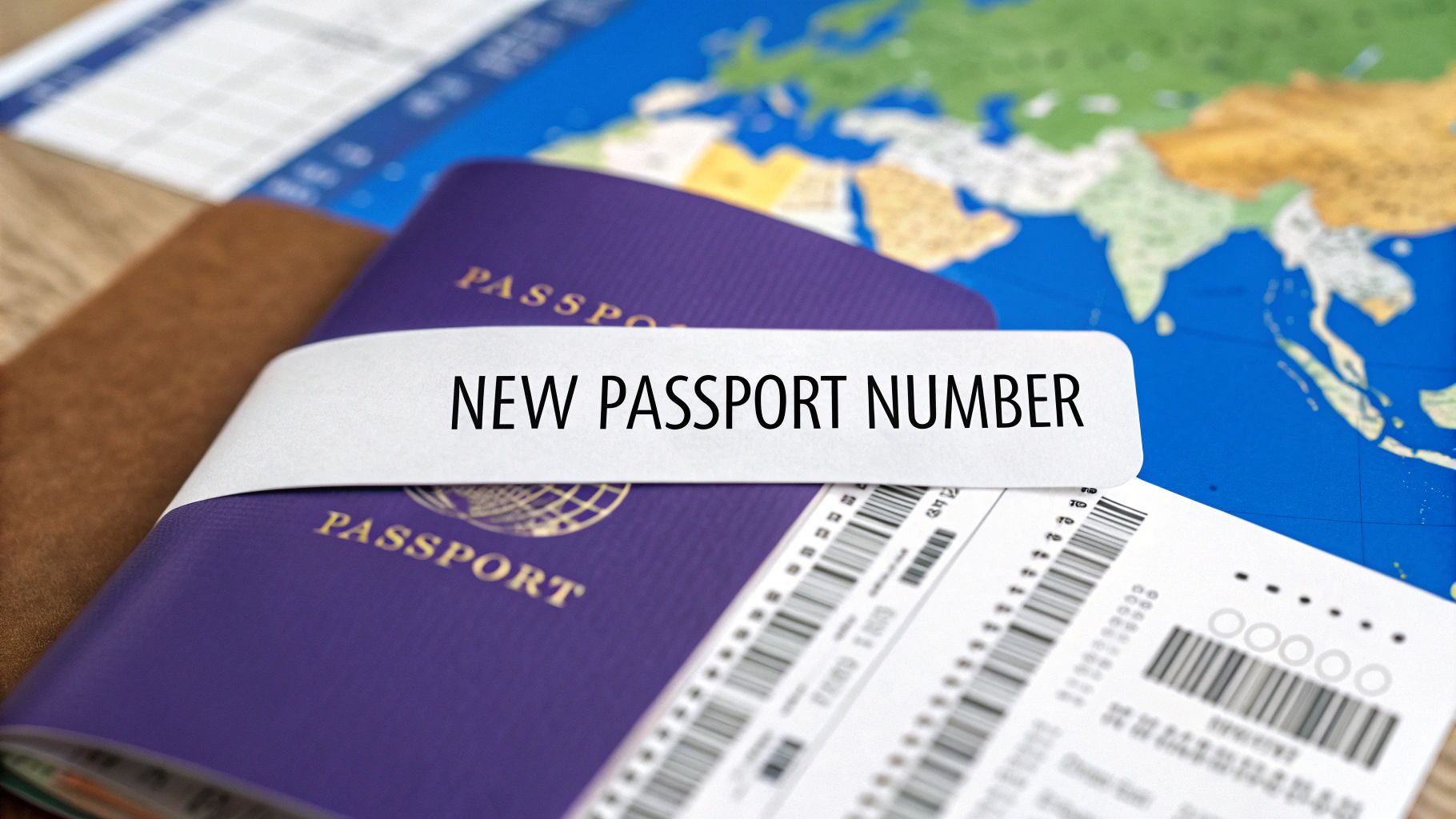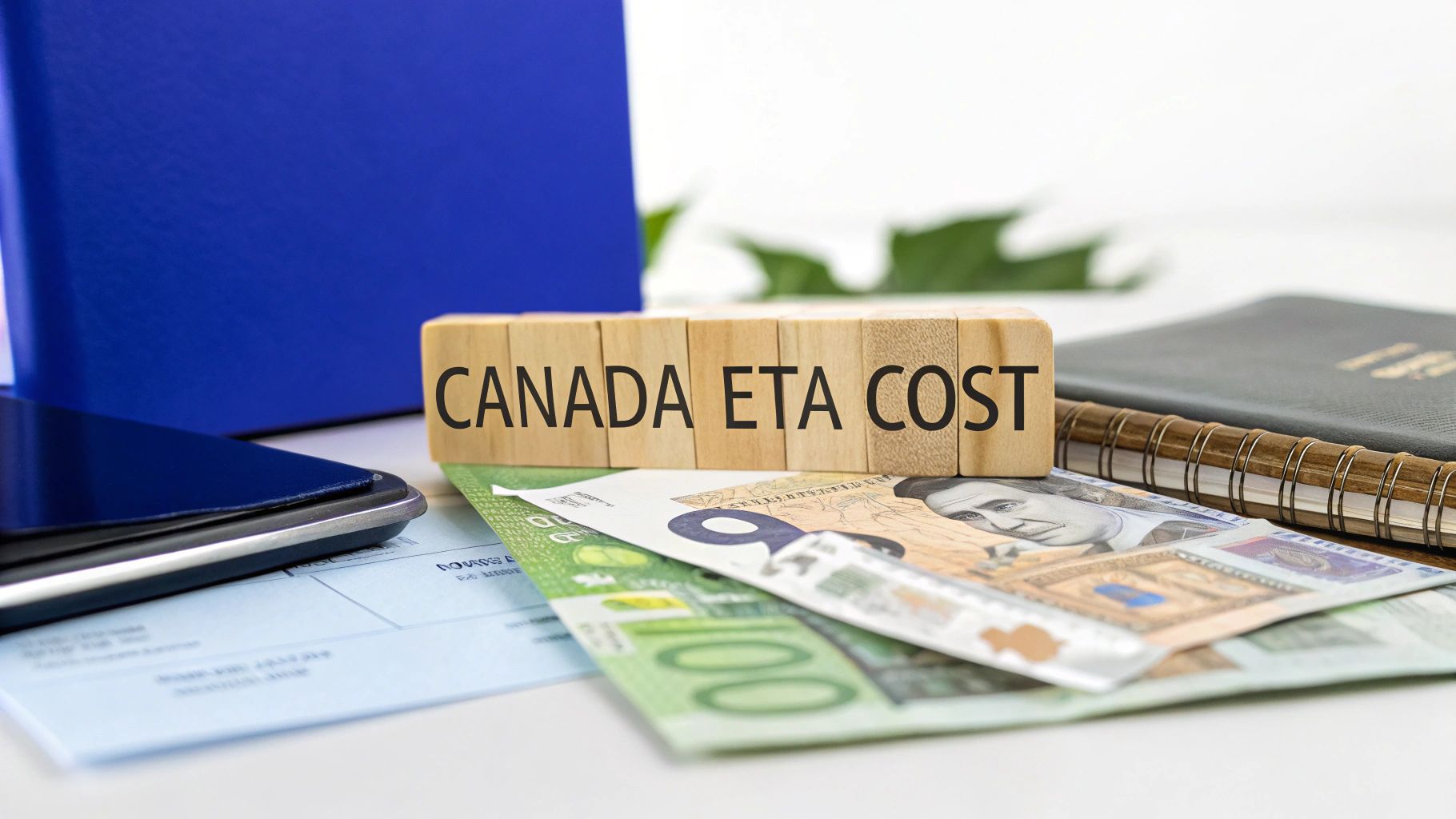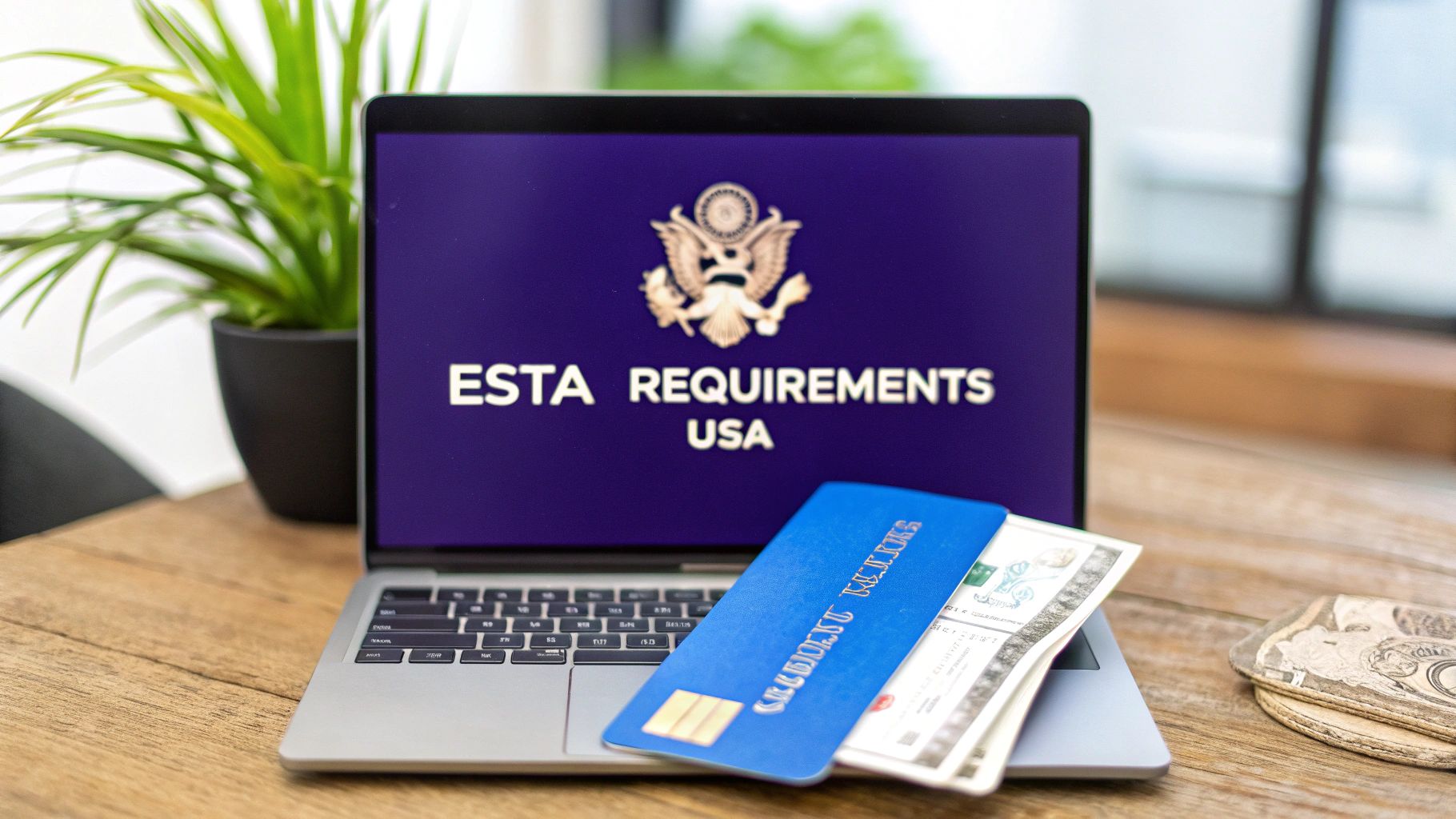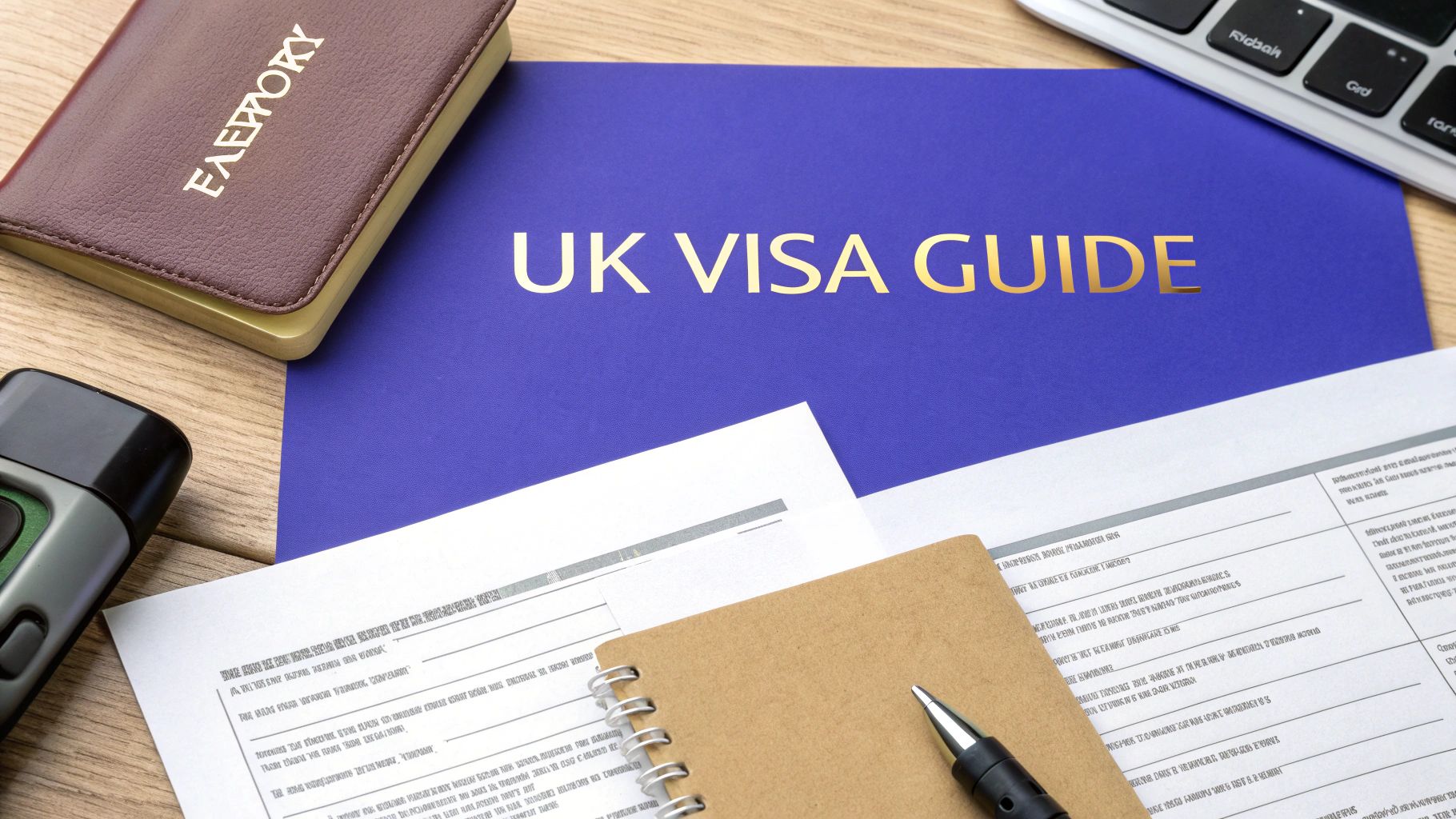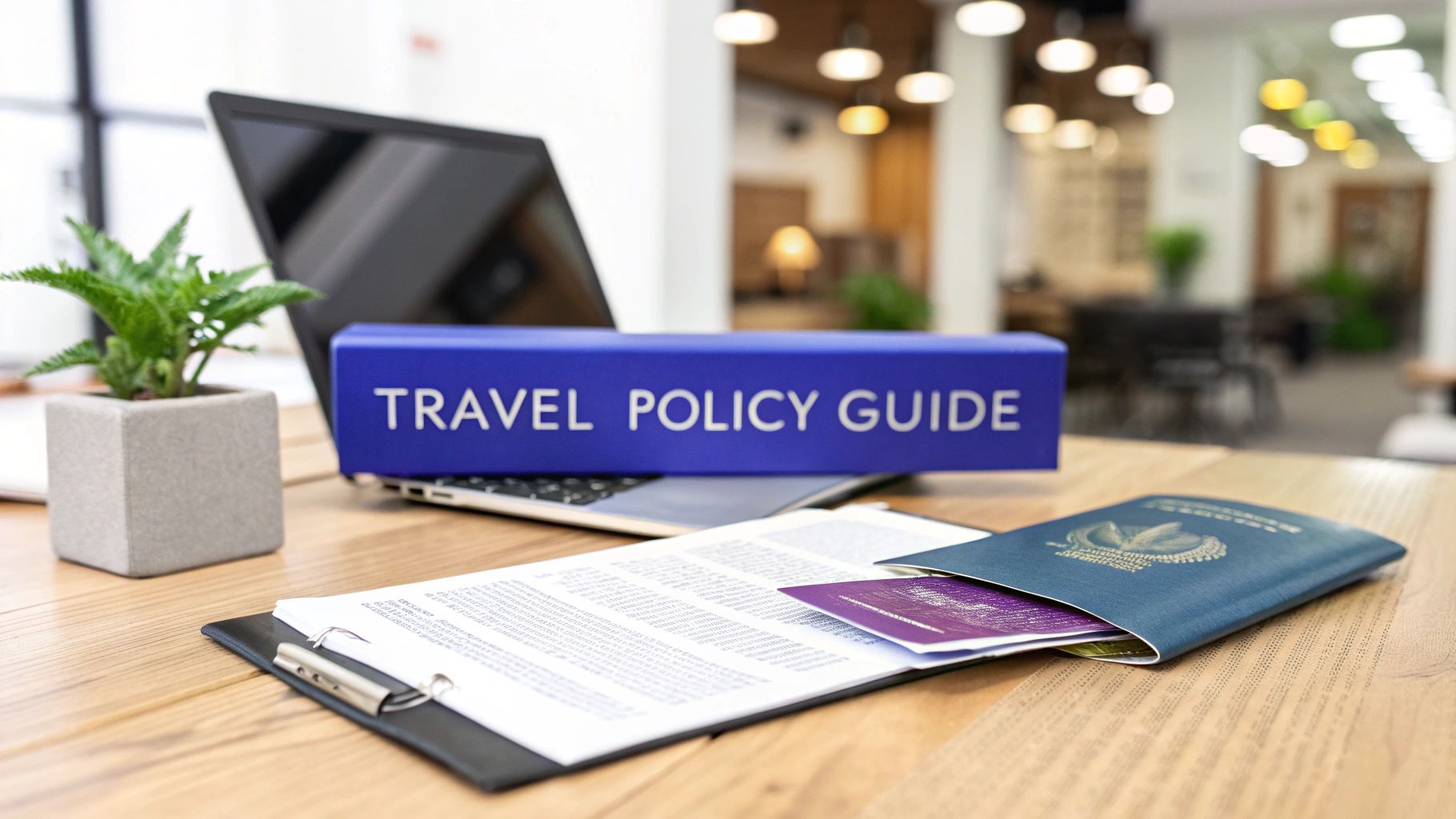
A Guide to Business Travel Expense Management
Business travel expense management is simply the system your company uses to track, audit, and reimburse employees for money they spend on work-related trips. It all comes down to creating a clear travel policy, a simple way to capture receipts, and using the right tools to keep costs in check. When it works well, you get a clear view of your budget and can stop overspending before it starts.
Building a Modern Travel Expense Framework
To really get a handle on travel costs, you need a solid foundation—not just a dusty old rulebook that no one reads. A modern business travel expense management framework is less about rigid, restrictive guidelines and more about creating a clear, fair system that actually fits your company's culture and financial goals. The goal is to empower your team, not tie their hands.
The first step is figuring out how to track business expenses effectively. Once you have that clarity, you can build a practical guide that helps employees make smart spending decisions. This is what minimizes those painful compliance headaches and makes the whole process smoother for everyone involved.
Defining Your Core Principles
Before you get lost in the weeds of specific rules, take a step back and establish the core principles of your travel policy. Think of these as your North Star, guiding decisions when a specific situation isn't spelled out in black and white.
Key principles often boil down to a few simple ideas:
- Employee Well-being: Your team's travel should be safe and comfortable, not a one-way ticket to burnout.
- Fiscal Responsibility: This one's easy. Spend company money as if it were your own.
- Efficiency: Cut down on the administrative busywork for both your travelers and the finance team.
For example, your policy should clear up gray areas like per diems versus actual meal expenses. A simple clause like, "Employees will be reimbursed for actual meal costs up to $75 per day with itemized receipts," removes all ambiguity and keeps everyone on the same page.
This chart shows what happens when you get it right.
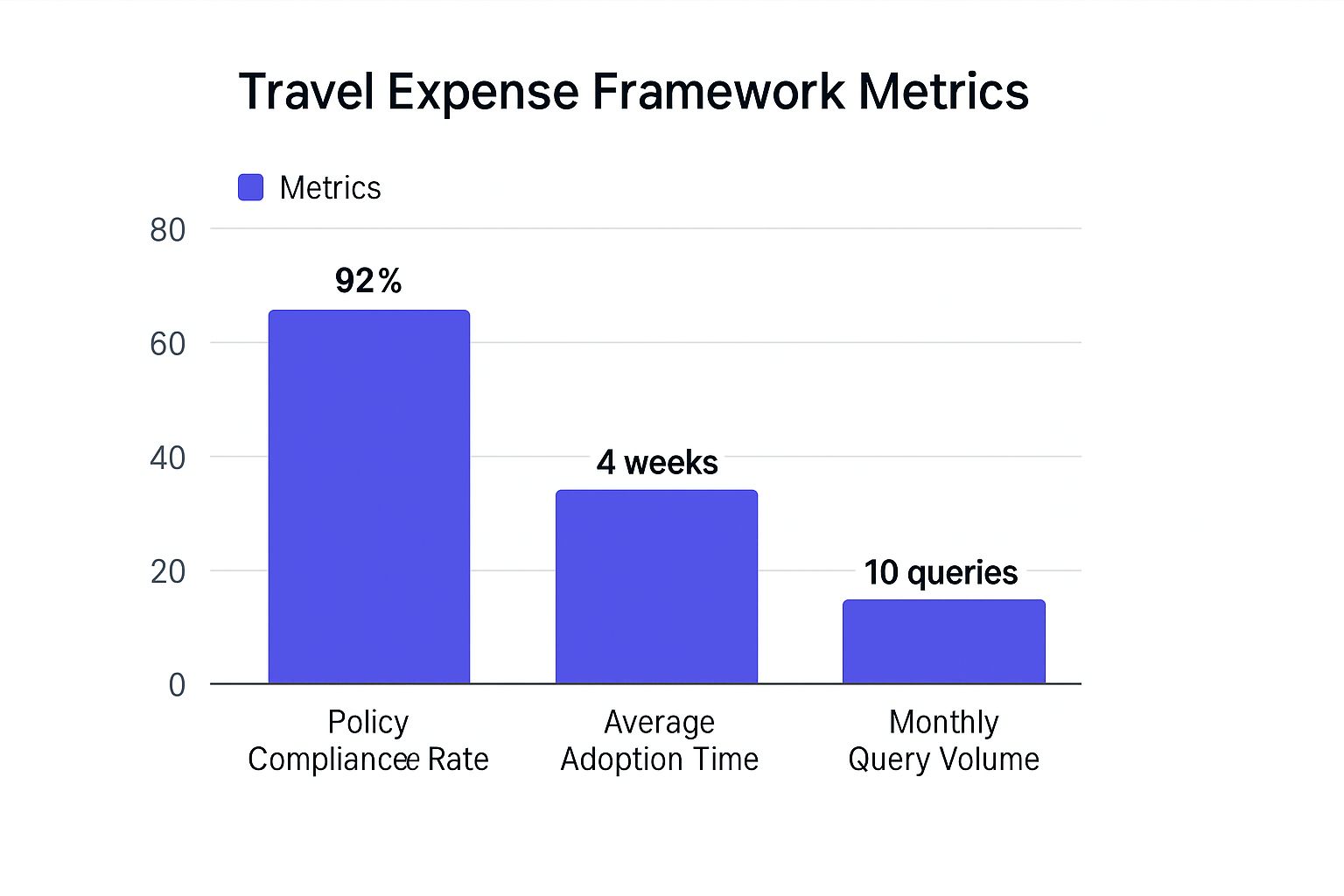
The data speaks for itself: a high compliance rate and a low number of questions mean your policy is clear and easy to follow. That's the goal.
Setting the Stage for International Travel
When your employees head overseas, a whole new layer of complexity kicks in. You've got currency conversions, different cultural norms, and specific entry requirements to deal with. Your framework should prepare them for what's ahead.
For instance, a trip to Canada involves more than just booking a flight. Your team needs to understand the entry rules, including the Canada eTA requirements, and knowing the best time to visit Canada can even help with budgeting and planning a more effective trip.
A successful travel expense framework anticipates needs. It should provide resources on everything from booking channels to required travel authorizations, ensuring employees are prepared and compliant long before they board their flight.
To simplify the Canada eTA application and increase your chances of approval, consider using a third-party application assistance provider like AssistEntry. Their experts guide you through the entire process, starting from just $79, which includes the government fee. They provide full verification of the application and error-checking to ensure compliance, which is a great way to avoid delays.
Designing a Travel Policy People Actually Follow

Let's be honest: nobody likes a travel policy that feels like a rulebook written by a committee that's never been on the road. The best policies strike a careful balance between keeping costs in check and making sure your team feels valued, not micromanaged.
A policy that's too restrictive just invites frustration and creative workarounds. On the flip side, one that's too loose is an open invitation for runaway spending. The sweet spot is a set of clear, fair guidelines that work in the real world.
This means going beyond a simple list of "dos and don'ts." A modern policy needs to tackle nuanced situations, like "bleisure" travel where employees add personal vacation days to a business trip, or the growing demand for sustainable travel options. When you build your policy around fairness and common sense, you create a system people actually respect and follow.
Setting Clear and Realistic Spending Limits
Vague guidelines are the number one reason for out-of-policy spending. Instead of a fuzzy instruction like "book reasonable flights," you need to define exactly what that means. Specify booking classes (like economy for flights under six hours), list preferred airlines, and outline a clear process for any exceptions. It removes the guesswork.
The same goes for hotels and meals. Give your team a solid per diem rate or a clear spending cap based on city tiers. This empowers employees to make confident decisions on the road and makes the auditing process a breeze for your finance team.
- Flights: A simple rule like requiring bookings at least 14 days in advance can save a surprising amount of money.
- Hotels: Create a list of preferred hotel partners that offer corporate rates, or just set a clear nightly cap based on the destination.
- Ground Transport: Define when it makes sense to use a ride-sharing service versus renting a car or grabbing a train ticket.
Clarity is kindness. It helps your team spend confidently and cuts down on the back-and-forth questioning of expense reports.
To help you get started, here’s a breakdown of the core elements every modern travel policy should have.
Key Components of a Modern Travel Policy
This table summarizes the essential elements every corporate travel and expense policy should include to ensure clarity and compliance.
| Policy Component | Key Considerations | Example Guideline |
|---|---|---|
| Booking & Reservations | Preferred booking tools, advance booking requirements, and approval workflows. | All flights must be booked through the company’s designated online booking tool at least 14 days prior to departure. |
| Air Travel | Cabin class rules (economy, business), preferred airlines, and rules for upgrades. | Economy class is standard for all domestic flights; business class is approved for international flights over 8 hours. |
| Accommodations | Nightly rate caps by city, preferred hotel chains, and rules for non-hotel stays (e.g., Airbnb). | The nightly hotel rate should not exceed $250 in Tier 1 cities (e.g., New York, London) without prior approval. |
| Meals & Entertainment | Per diem allowances, guidelines for client entertainment, and rules regarding alcohol. | A daily meal per diem of $75 is provided. Client entertainment expenses require itemized receipts and attendee names. |
| Ground Transportation | Policies for rental cars, ride-sharing services, and public transport. | Ride-sharing services are preferred for trips under 20 miles; rental cars require manager approval for trips longer than two days. |
| Expense Reporting | Deadlines for submission, receipt requirements, and required documentation. | All expense reports must be submitted with itemized receipts within 15 days of trip completion. |
| Safety & Security | Emergency contact procedures, travel insurance requirements, and duty of care protocols. | All employees on international trips must register their itinerary with our travel risk management provider. |
Having these components clearly defined removes ambiguity and gives both travelers and approvers the confidence that they're making the right decisions.
Navigating Budget Pressures and Travel Demands
The corporate travel world is tricky right now. Everyone agrees that in-person meetings are incredibly valuable, but at the same time, there's immense pressure to tighten the belt. This puts travel managers and CFOs in a tough spot.
Recent industry data highlights this tension perfectly. While most CFOs expect their travel budgets to stay flat or even grow, about one in five large companies is planning to shrink theirs. Meanwhile, 69% of travel managers feel their current budgets aren't enough to meet the company's goals. You can see the full picture in this in-depth analysis of business travel complexity. This reality demands a policy that’s both smart and flexible—one that prioritizes high-impact trips while finding savings wherever possible.
Addressing International Travel Complexities
Flying internationally adds a whole new layer of complexity, from visas and entry rules to safety protocols. A great policy anticipates these challenges and prepares employees for them.
For example, if your team often travels to the United Kingdom, your policy should have a section on the required Electronic Travel Authorization for UK, necessary travel documents, and what insurance is required. For a deeper dive on that topic, check out our guide on the best travel insurance for UK trips.
A truly effective travel policy is a living document. It should be communicated clearly, reviewed regularly, and updated to reflect changing business needs, employee feedback, and global travel conditions.
At the end of the day, a policy that people actually follow is one that feels less like a rulebook and more like a supportive guide designed to help them succeed—and stay safe—on the road.
Modernizing How You Capture and Report Expenses

The days of chasing down crumpled paper receipts and manually plugging every line item into a spreadsheet are, thankfully, behind us. Effective business travel expense management is now all about using modern tools to capture and report expenses with as little friction as possible.
This shift does more than just save a few minutes; it drastically cuts the administrative load for both your travelers and your finance team. When you get this right, you get faster insights into travel spend, much better data accuracy, and you free up everyone’s time for more important work. The goal is to make expense reporting an afterthought, not a dreaded chore.
Embracing Mobile and AI-Powered Tools
The biggest change in expense reporting comes from the device everyone already has in their pocket: their smartphone. Mobile receipt scanning is a genuine game-changer. Employees can just snap a photo of a receipt the moment they get it, and the software handles the rest.
This is where AI really shines. Modern expense management platforms use it to:
- Extract Key Data: Automatically pull the vendor name, date, and amount right from the receipt image.
- Categorize Expenses: Intelligently assign the expense to the correct bucket, like "Meals" or "Ground Transportation."
- Flag Policy Violations: Instantly identify potential issues, like a dinner that goes over the daily per diem.
This kind of automation means employees spend a few minutes, not hours, on their expense reports. Your finance team, in turn, can stop reviewing every single line item and focus only on the exceptions.
Your technology should do the heavy lifting. By integrating corporate cards and AI-powered tools, you transform expense reporting from a tedious data entry task into a simple process of review and submission.
Encouraging Timely Submissions
Even with the best tools, getting employees to submit their expenses on time can be a headache. Procrastination doesn't just frustrate your finance team; it gives you an inaccurate picture of your company's financial health.
The key is to make submitting on time the path of least resistance.
A great starting point is setting up automated reminders. A gentle nudge a week before the deadline and another on the day it's due can work wonders. It also helps to clearly state the submission deadline in your travel policy to remove any confusion. Some companies even link timely reports to faster reimbursement, which creates a very direct incentive.
For international travel, especially to places like the UK, good planning is just as important as post-trip reporting. Understanding how to apply for a UK ETA is crucial for a smooth journey. You can learn more about these specifics in our guide on the UK ETA application process, which helps travelers get ready for their visit. This sort of preparation sets the stage for a trip where your team can focus on business, not paperwork.
Using Automation for Audits and Reimbursements
Let’s be honest: manual expense audits are a massive bottleneck. They’re slow, riddled with potential human error, and drain valuable hours from a finance team that could be focused on much bigger things.
The fix? Leaning on technology to automate both the auditing and reimbursement steps. This is how you gain speed, tighten up compliance, and keep your traveling employees happy all at once. It’s a game-changer.
This approach transforms your finance team from manual reviewers into strategic overseers. Instead of painstakingly checking every single line item, they can manage by exception—stepping in only when an expense truly needs a human touch.
Setting Up Smart Auditing Rules
The heart of an automated audit is a set of smart, custom rules that instantly flag potential problems. Modern expense management software lets you build a compliance engine that checks every submission against your travel policy in real-time.
You can set up rules to automatically catch common issues like:
- Duplicate Submissions: The system can spot if the same receipt has been uploaded more than once, stopping accidental—or intentional—double payments in their tracks.
- Out-of-Policy Expenses: If a dinner goes over the per diem or a flight is booked in the wrong class, the system flags it immediately for a closer look.
- Missing Information: The software can kick back any report that’s missing crucial details, like an itemized receipt for a meal or a list of attendees for that client dinner.
This proactive method stops problems before they even start. The result? You can expect 90% or more of your expense reports to sail right through the approval process without anyone needing to lift a finger. Understanding the full scope of business process automation benefits shows just how much of an impact this can have across your entire company.
Enabling Faster, Trustworthy Reimbursements
Once an expense report is approved, the final step is getting that money back to your employee. A slow reimbursement cycle is one of the quickest ways to frustrate a business traveler and erode trust. Waiting weeks to get paid back is a relic of the past—or at least, it should be.
By integrating your expense software directly with your accounting and payroll systems, you can set up fast, direct-deposit reimbursements. The moment a report gets the final green light, the payment can be triggered automatically.
A seamless, automated reimbursement process is a powerful signal to employees that you value their time and trust them. It turns a potential point of friction into a genuinely positive experience that reinforces a healthy company culture.
This one change—moving from manual checks to automated deposits—can make a huge difference in employee morale. It’s also important to keep people in the loop. Think about it: just as you'd want to check your visa application status while waiting for travel documents, clear communication about reimbursement timelines builds confidence in both the system and the company.
Turning Expense Data into Strategic Insights
Effective business travel expense management is so much more than just shuffling receipts and paying people back. The real magic is in the data you collect.
When you stop looking at expense reports as an administrative chore and start seeing them as a source of business intelligence, you unlock some serious strategic advantages. Every single transaction—from a flight booking to a client dinner—tells a story about how, when, and where your company is spending money.
By digging into this data, you can finally move from a reactive "process and pay" model to a proactive approach that saves money, tightens up your forecasting, and proves the real value of your travel program.
Uncovering Cost-Saving Opportunities
Believe it or not, your expense data is a goldmine for finding places to cut costs without hurting business goals. When you start analyzing spending patterns over time, you can spot trends that would otherwise fly completely under the radar. This is where your system goes from being a simple record-keeper to a powerful strategic tool.
You'll want to look for insights like:
- Top Vendors: Who are your most-used airlines and hotel chains? Knowing this gives you massive leverage to negotiate corporate rates or preferred partner discounts.
- Booking Behavior: Are your employees booking flights at the last minute, causing costs to spike? This data might highlight the need for a clearer policy on booking in advance.
- Category Overspending: Is one department consistently spending way more on Ubers than others? This could be a sign that a bit of training or policy clarification is in order.
This analytical approach lets you make targeted, data-driven decisions instead of just implementing broad, frustrating budget cuts that hurt morale and productivity.
Tracking Key Performance Metrics
To get a real handle on the health of your travel program, you need to be tracking the right metrics. These numbers give you a clean snapshot of performance and help you measure the impact of any changes you make.
By transforming raw numbers into actionable intelligence, you can manage travel budgets proactively, forecast spending with greater accuracy, and prove the ROI of your company's travel investments.
Consider keeping an eye on these critical numbers:
- Average Trip Cost: How much does a typical trip cost by department, destination, or even by individual employee?
- Policy Compliance Rate: What percentage of expenses are actually submitted in line with your travel policy? A low rate is a big red flag that your policy is either confusing or just plain unrealistic.
- Expense Report Processing Time: How long does it take to get someone reimbursed after they submit a report? A faster cycle time is a key indicator of an efficient, well-oiled system.
Forecasting Budgets and Managing Global Spend
Accurate data is the bedrock of reliable budget forecasting. When you have a clear picture of historical spending, you can predict future travel costs with much more confidence, which helps every department plan their budgets more effectively. This is especially vital in today's growing global market.
The scale of international business travel is massive. Projections show that global business travel spending is set to hit a record $1.57 trillion in 2025, and it’s not expected to slow down. For a closer look at these trends, the Global Business L's comprehensive forecast is worth a read.
This growth makes it crucial to have precise data for managing costs across different regions and currencies. Handling international expenses also means getting a grip on local regulations and costs, much like you’d research New Zealand visa charges before a trip to make sure every cost is accounted for.
Balancing Sustainability with Smarter Spending
These days, business travel expense management goes way beyond just crunching numbers on budgets and receipts. It’s also about environmental and social responsibility. Weaving sustainability into your corporate travel policy isn’t just a nice-to-have anymore; it's a core part of a modern, forward-thinking strategy.
This shift isn't just about "being green"—it’s about being deliberate. When you encourage greener choices, like prioritizing trains for shorter trips or booking eco-certified hotels, you naturally start spending smarter. As soon as you begin tracking your carbon footprint, you also start paying much closer attention to the efficiency and necessity of every single trip.
Making Sustainable Choices Easy
If you want your team to travel sustainably, you have to make it the path of least resistance. Instead of punishing less-green options, your policy should actively reward or simplify the greener ones.
Here are a few practical ways to do that:
- Prioritize Rail Travel: For any route where a train is a viable option, make it the default in your booking tool. This works incredibly well in places like Europe with its extensive high-speed rail networks.
- Highlight Eco-Certified Partners: Put together a preferred list of hotels that have solid sustainability certifications. This guides your team toward responsible choices without making them do hours of extra research.
- Offer Carbon Offsetting: Give employees the option to offset the carbon footprint of their flights, with the company covering the cost.
This approach frames sustainability as a positive choice, not a restrictive chore, which does wonders for adoption and employee morale.
The Financial Upside of Going Green
A major trend shaping business travel right now is this dual focus on sustainability and smarter spending. By 2025, more and more companies are baking sustainability criteria right into their travel policies, favoring lower-emission transport like rail over short-haul flights. This shift isn't just about hitting corporate green goals; it also drives better expense choices.
As you can discover in more detail from business travel statistics, this pivot reflects a blend of environmental concern and good old-fashioned financial prudence. We're moving away from broad, generic allowances toward more targeted, impact-conscious spending.
When your team starts thinking about the environmental impact of a trip, they inherently start questioning its overall efficiency. This mindset naturally curbs unnecessary spending and promotes more thoughtful planning.
For instance, a trip to the UK requires careful coordination. It’s not just about booking flights. Making sure your team has the necessary travel authorization for UK, like the UK ETA, is a crucial part of responsible and efficient planning. This kind of pre-trip diligence prevents costly last-minute problems and aligns perfectly with a more deliberate approach to travel.
Navigating new travel requirements like the UK ETA can be a headache. For a smooth and error-free process, let AssistEntry handle the details. Their experts review your UK ETA application for compliance, seriously increasing your chances of approval. Get your UK ETA application started with AssistEntry for just $79, which includes all government fees.
